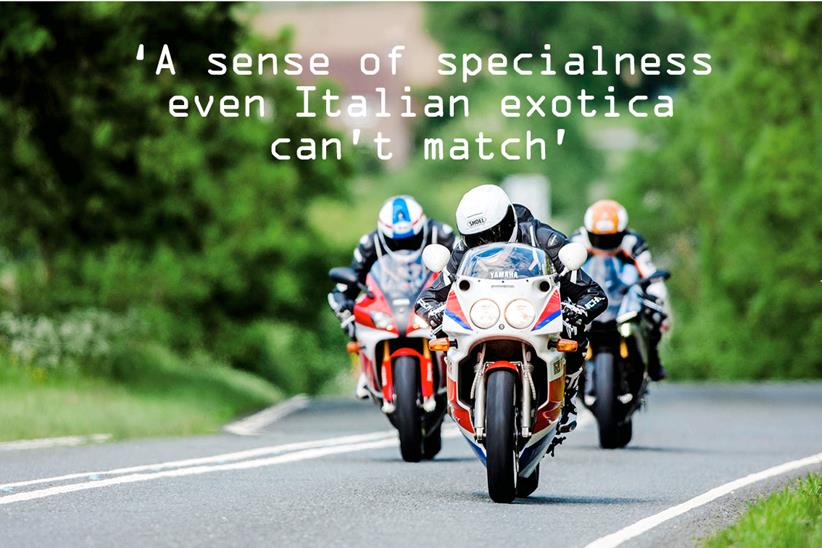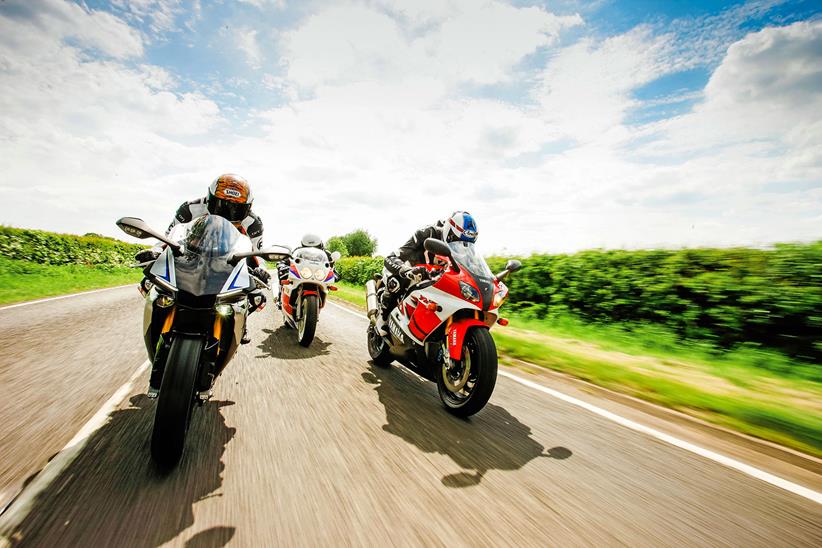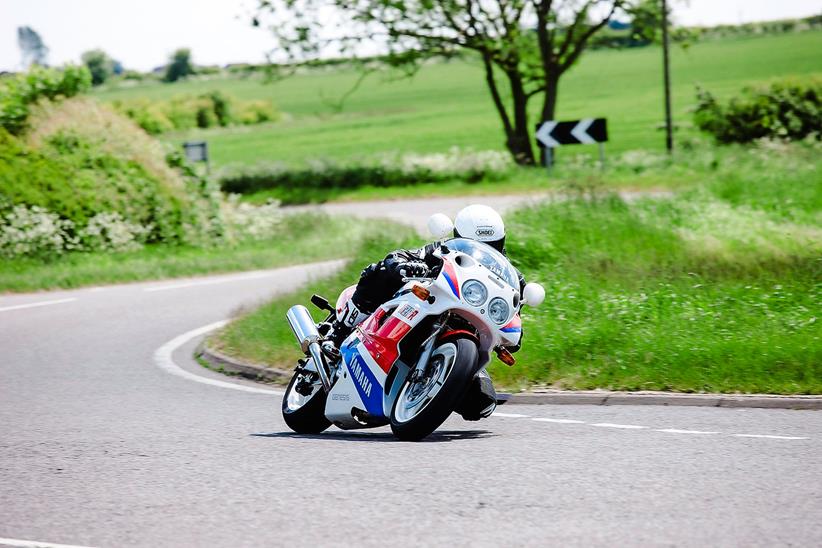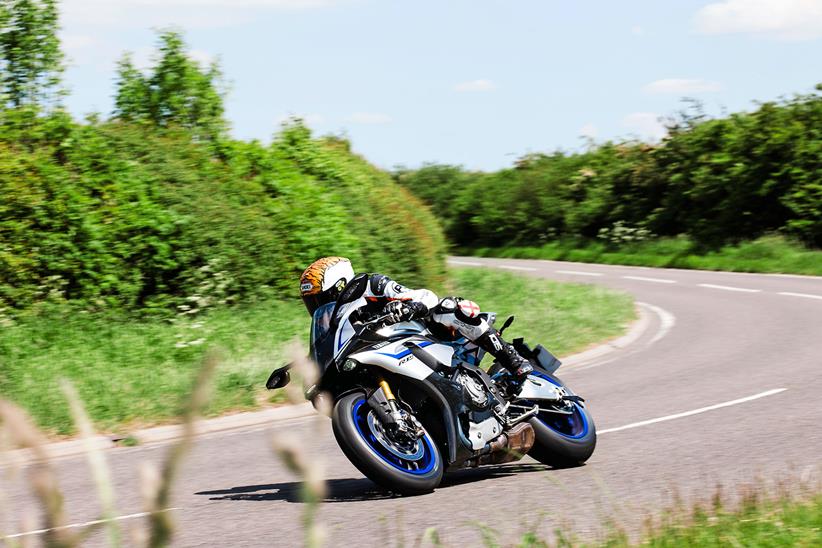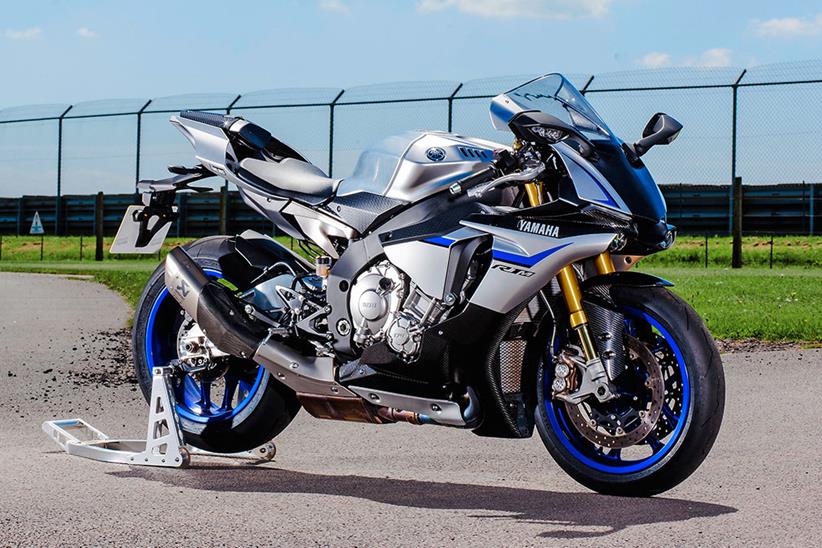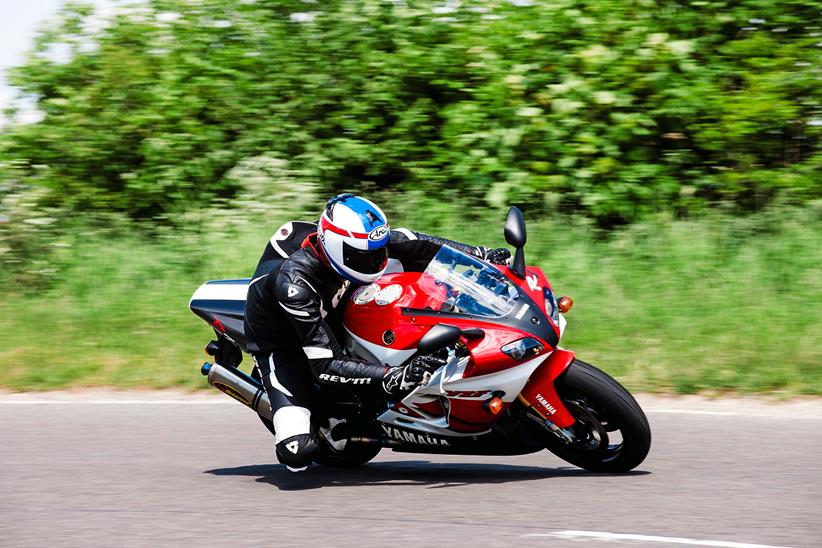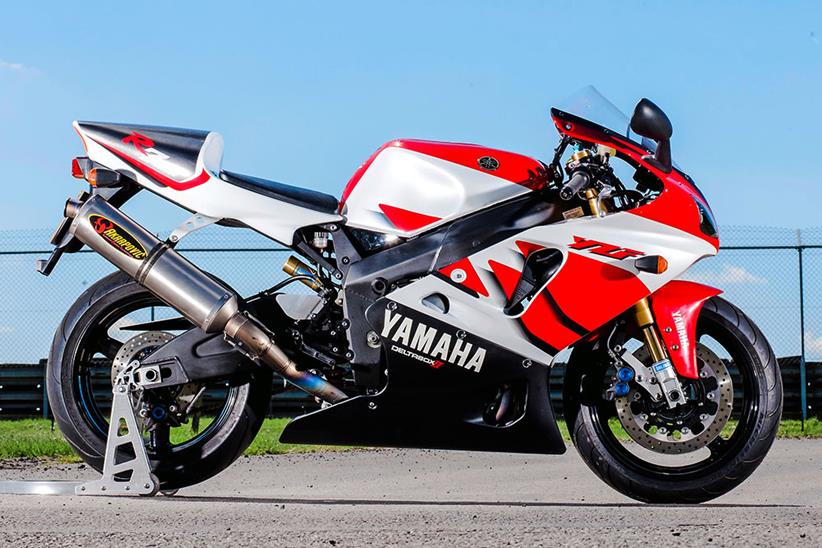Is the R1M worthy of entering Yamaha's hall of homologation heroes?
The new R1M joins the OW01 and R7 in Yamaha’s exclusive homologation specials club. But just how harmoniously does the tuning fork’s latest fit in?
![]() he R1M is the sexiest limited-edition bike to emerge from Japan for a generation. Swathed in carbon, packed with MotoGP tech and with enough electronics to wage war on the West, it’s a sure sign that Japan are back, fighting at the cutting edge of sportsbike technology.
he R1M is the sexiest limited-edition bike to emerge from Japan for a generation. Swathed in carbon, packed with MotoGP tech and with enough electronics to wage war on the West, it’s a sure sign that Japan are back, fighting at the cutting edge of sportsbike technology.
Just 500 have been produced and the advantage they give over the standard model means they have been snapped up by racers and collectors the world over. But it isn’t the first time the world has gone crazy for a limited-edition Yamaha. In 1989 the 750cc OW01 was a true object of desire and a real rival to the RC30, while in 1999 the YZF-R7 was so advanced it’s still trick now.
It seemed like the perfect time to get the three of them together. It’s time for the R1M to meet the family.
FZR750RR OW01
1989-1992 / 121bhp / 210kg
Parked next to a brand new R1M and an immaculate, rare R7, an OW01 hailing from a quarter of a century ago is in danger of looking antique. Nice, in an ‘Aw, bless’ way; a classic with a proud history… but, like grandad inadvertently farting at dinner, quietly embarrassing in present company.
And when my considerable bulk settles on the seat, compressing the standard-fit Öhlins into an undignified, bum-dragging ride height typical of many late 1980s sportsbikes, the day starts to bear all the hallmarks of one spent making excuses for the old girl. It’s the Brussels sprouts, etc.
But it turns out not to be like that at all. When Mark, on the R1M, and Matt, on the R7, clear off in a blur of revs into the back roads of a leafy Lincs Wolds, the OW01 isn’t just able to keep up – it soon leads the way, comfortable doing so at a decent pace.
![]()
It’s the first time I’ve ridden any of the exotic, limited-edition, race homologation Yamahas. And the OW01 is almost as limited as the R7 and R1M: like them, Yamaha initially only built 500 OWs in 1989, based on the Suzuka 8hr-winning YZF750 factory racers of 1987 and 1988, to compete with Honda’s RC30 wherever they met – endurance, national or domestic superbike championships.
The Honda and Yamaha competed on spec, too – the OW01 boasts titanium rods, twin-ring pistons, aluminium tank with endurance-style filler cap, detachable ally subframe, quick-release front axle clamps, fully-adjustable forks and Öhlins rear shock with hydraulic preload adjuster – all that as well as a radically oversquare (bore and stroke are the same as the R7’s, a decade later), high-revving, five-valve Genesis lump in an aluminium Deltabox frame. And all for an asking price of £12,700 in 1989; more than £28,000 in today’s money – or £10 grand more than an R1M, six grand more than an R7 in 1999, and more than twice the price of a 1989 FZR1000 EXUP. Basically, it’s the most expensive Yamaha with lights, ever.
And now I’m riding an FZR750R OW01, and intensely relieved to find it’s anything but an anti-climax. Yes, it feels low at the back and the bars are a 1980s reach away across that flat aluminium endurance tank. But as soon as it starts rolling, gently feeding out the clutch to avoid that classic Yamaha grabbiness, it feels so very, very right.
The engine is fit and oil-tight, pulling with a glassily-smooth urge from walking pace in classic five-valve 750cc Genesis style, as if the crank is spinning in hot butter. It reminds me of a YZF750 (it was based on the OW’s motor) in general character, sensation and power output. EXUP-assisted midrange drive is a happy balance of useable grunt, short-shifting gears up and down through one of the sweetest boxes I’ve ever used. I’m a bit wary because the thought of sending one of those titanium rods spearing through the cases in a bid for freedom is too horrible to contemplate, so to start with I go for gears well before the 13,000rpm redline.
![]()
The 39mm Keihin flatslides, fitted instead of standard 38mm Mikuni CVs, are a brilliant way to fuel an engine, even just for the throttle slides rattling at tickover. Bang them open at less than 7000rpm and the motor bogs down, so you can’t just sit there with the taps open and wait for the engine to catch up. You have to ride where the power wants you to, juggling throttle, revs and gears, like the old days, or a two-stroke.
Suspension is YZF-ish, too; fresh despite its years. Damping is supple and progressive, feeding quality bump information back from contemporary 180/55, 120/70 Bridgestone S20 tyres on the OW01’s 17in rims.
But, best of all, its steering is light, responsive and entirely neutral. There’s no significant bar pressure needed to make the OW turn – it flicks from side to side with an easy, fluid roll. Not cut-throat quick, but there’s none of the horrible, trail-heavy steering caused by a collapsing shock.
As the day unwinds in a series of hectic corners, it’s clear the OW01 prefers less of the point-and-squirt riding of today’s superbikes, and more of a refined, conservation of momentum riding style. With as much power on tap as a modern 600 it doesn’t need electronics to control a mountain range of power – all it asks is you accelerate gently enough not to wreck the motor and brake as little as possible. But not because the brakes are poor; pinpoint and powerful four-pot Nissins nip 320mm discs with a modern feel, progression and no sponginess.
It’s a fantastic feeling, head down between the hoover tube induction pipes, peering through the alloy screen brace and generally acting like it’s the early 1990s all over again. The induction roar echoing up from the carbs though the tank is bewitching.
![]()
Ahead, Matt and Mark pull up for a chat, and to swap bikes. Matt disappears on OW01, so I bag a quick blast on the R1M – brain duly shattered by the sheer intensity of the power coupled with intoxication by the V4-style power delivery – and then the R7. I’ve never ridden one of these either – and I agree with Matt and Mark; no fault of the R7’s owner and builder (who was still fettling it this morning and hasn’t had a chance to finish it) but that’s how it feels: unfinished. The suspension needs setting up, tyres changing and fuelling sorting.
Matt returns from his blast on the 1989 Yamaha. “I like it; it’s lovely,” he says, before going back to stroking his chin and contemplating ways the R7 needs fixing.
We take off again and this time I give the OW01 some welly. Despite its clean condition, it’s clearly had some in the past so it should be able to stand it: the hard rubber on the footpegs is pleasingly worn almost down to the metal, belying the 12,500 clock mileage. The OW01’s owner, Geoff Cox, says he bought it last year and was lucky to find one unraced, and relatively fettled.
“It was imported from Japan around six years ago and owned by an elderly chap who was an ex-drag racer, but he found it too cramped,” says Geoff, who also owns an RC30. “When I first rode the OW01, it was underpowered compared to my Honda. So I took it to PDQ in Taplow for a service. They said whoever fitted the flatslide carbs didn’t realise they needed longer throttle cables or the slides wouldn’t open fully. Replacement cables have renewed the engine.”
Ride over, I park up the OW. Then I notice the reg plate: YAM 750R. It’s not a show plate. “The previous owner asked DVLA if he could buy YAM 750R as a number plate, as it had never been allocated to a vehicle,” says Geoff. “The DVLA put the registration up for auction, and he paid £2000 for it! If someone wants to make me an offer…”.
That’s just for the plate; I get the feeling the OW01 isn’t for sale at any price. And quite right too. You’ll never get another one.
![]()
ICONIC RACER: Carl Fogarty, 1992 senior TTOW01s won many World Superbike and endurance races, but few set lap records that lasted as long Foggy’s 123.61mph lap of the TT, which lasted until 1999. Embroiled in a bitter battle with Norton Rotary-equipped Steve Hislop, Carl gave no quarter to the race-kitted British Supercup-spec OW01, blowing the fork seals, rear shock and exhaust in an attempt to wrestle the TT victory from Hizzy. He eventually lost the race by 4.4s. His historic race bike is now owned by the Manx Government. |
EngineType 20v inline four |
DimensionsWheelbase 1410mm |
ChassisFrame Aluminium twin-spar |
BuyingPrice then £12,700 |
YZF-R7 OW-02
1999-2001 / 106bhp / 193kg
![]()
Sixteen years of sportsbike development haven’t dimmed the shine of the jewel-like YZF-R7 OW-02. Built as a final roll of the dice in an attempt to wrest a 750cc WSB title from Ducati, it was the pinnacle of Japanese sportsbike engineering, with a lightweight, sharp-steering chassis loosely based on a 500 GP bike, an engine packed with cutting-edge tech and a rabid desire for revs.
With its bug-eyed projector lights, trademark speedblock paintjob and possibly the most exquisite braced and plated swingarm ever to appear on a production bike, it was right at the cutting edge of Japanese exotica. Now parked up in a layby with the OW01 and R1M, it still feels like it.
Exclusive, effusive and on UK roads at least, elusive, the R7 feels the most special bike here, and even after just a short ride on it, I’d happy kill a close family member to own one. Wouldn’t even wince.
Even in stock form the motor is a masterpiece of 1990s motorcycle development. Five valves per cylinder, forged pistons, titanium rods, titanium valves, super-trick fuel injection with twin injectors plus a slipper clutch were all wondrous things at a time when most Jap sportsbikes still had carbs and 20-year-old architecture.
![]()
But you needed to unlock the potential. All R7s imported to Europe came with 106bhp, made impotent by disconnecting the throttle body’s upper injectors to please German and French power laws. And most bikes tested by mags were in this state, too – so the Great Voice of Journalism declared the R7’s motor a bit crap, especially once racebikes started eating cranks on a regular basis. At £21k it was also twice the price of an original R1 but slower. What a waste of money. Thank God they only made 500 of them, eh?
But the truth is somewhat different. A race kit loom switches on the second injectors and combined with a full system means an easy, glorious 140bhp and lets you revel in the joy of an engine performing as the engineering gods intended. This is the state that PB reader Andy Day’s 8000-mile road bike is in.
As you blip the short-action throttle, the revs rise and fall so fast that it beggars belief. The whole bike is alive, tingling with barely-perceptible high-frequency vibes, the exhaust gruff and hard-edged as it barks through that ultra-rare titanium Akra.
Riding it feels special. You slip the clutch through the kind of tall first gear that is the preserve of only the finest full-on racebikes, the engine gathering in intensity as revs rise. And it takes you by surprise how fast it is, gaining speed with relentless determination. Everything in the motor feels so smooth, like each component has been hand-finished, perfectly matched and made of the finest materials, which I suppose it has.
You can feel every suck, squeeze, bang and blow occurring in each cylinder, sense each coil and the tiny narrow-electrode plugs igniting the compressed charge and those titanium rods imparting leverage on that lightweight, ion-nitrified crank. It’s a common cliché to say that a conventionally-cranked four-cylinder motor is soulless, but this drips in race-bred heritage and intent.
![]()
There’s no redline on the clear, no-nonsense typically-Yamaha period dash, the motor want to keep on going forever. WSB racers went to 15,000rpm, but I choose 13,000rpm to change up. The gearchange (through the stock adjustable rearsets) is super-quick, precise and with a short throw. Revs barely drop as it slots into the next ratio.
And you’re back on the power, happily drowning in a sea of revs, tucked in and chasing the shift point. You only lose about 2000rpm and it’s impossible not to get intoxicated – and hold the throttle open to find that rush again. Your chin rests just above the ally tank’s cut-out, chest over the blank for the endurance-spec second fillers, view framed by the fairing brace, complete with factory-cable-tied breather tubes.
In this form the R7 cuts it. More raw, more involving and much quicker than any road RC45 I’ve ever ridden. The power, the speed means it is at least as fast as a modern-day GSX-R750. Pretty astounding stuff.
The fast, flowing corners of my favourite Lincolnshire A-road are the perfect venue for the R7. At 198kg fully fuelled the R7 is the weight of a modern sportsbike and aside from its width (it’s no smaller than a vintage R1) feels like one, changing direction with no resistance, unassailable at mid-lean.
There’s so much feedback. Despite needing a bit more set-up time, nothing is damped out, nothing left to chance; the grain, colour, even the chemical bloody composition of every grain of tarmac is telegraphed though those Öhlins forks, and as you pile on you know exactly how much grip the front tyre has, and how much traction the rear has.
It’s telling you so much that at times it is almost disconcerting. This bike is fitted with Michelin Pilot Power 2CT tyres, which don’t really suit it, but it’s not really anyone’s fault. Its owner only finished preparing the bike for us the day before and had slung on the Michelins, with a 180-section hoop squeezed onto the six-inch-wide rear, as Yamaha recommend. But Mark and I feel it would handle better with a 190/55 on the rear.
![]()
Thanks to the quality of the chassis, you can feel every percentage of grip as it ebbs away and nibble at its limits without fear of a sudden shock. With sticky, triangular rubber it would be simply astounding; on slicks it would be like riding a WSB wildcard.
In fact, if you’re rich, ownership of one of these is an enticing prospect. An R7 still costs about £21k sixteen years later and while zero-milers will always have an attraction to collectors, working bikes are always attractive and rise in value, too. Bikes like this don’t have to be for display only and this R7 gets trackdayed and thrashed regularly.
Simon, Mark and myself are riding in convoy and at the next fuel stop Mark and I swap bikes and I take the R1M for a ride. It is astounding in every way, making light of the bumps the R7 shakes its head on and giving huge confidence at big lean. But is isn’t as involving, isn’t as alive as the R7.
“What a special bike,” says Mark of the R7. “The way it revs is like nothing else I’ve ever ridden. For years I’ve thought people were doing the right thing by taking R1 engines and putting them in R7s, but now I’ve ridden one it’s like ripping the heart and soul from the bike. A sorted R7 is honestly like nothing else on the planet.”
![]()
ICONIC RACER: Noriuki Haga, 2000 WSBThe R7 fell short where the RC45 triumphed and never won a WSB title. But it went down in style. A test-bed for Yamaha’s YZR-M1 four-stroke MotoGP bike which debuted a few years later, Haga’s factory-run R7 boasted super-trick race-kit parts and direct development from Japan. Power was around 180bhp when BSB R7s barely managed 160bhp. In the running for the 2000 WSB title, a dispute about a positive drugs test ruled Haga out of contention at the end of the year. He managed four wins and 11 podiums, and won the hearts of a generation with some wild riding. Incidentally, the only rider to win a BSB race on an R7 is PB road tester Michael Rutter. |
EngineType 20v inline four |
ChassisFrame Aluminium twin-spar |
DimensionsWheelbase 1400mm |
BuyingPrice then £21,749 |
YZF-R1M
2015 / 197bhp / 194kg
![]()
For the last 10 years, my life has been defined by R1s. Each new incarnation has propagated a trouser tent, but none more than the new R1M. Over the years I’d fallen in love with the wobbly-cranked charms of the 2009 crossplane version and the thought of the offbeat power delivery of that bike combined with a small, tight, light chassis and the best suspension money can buy has made me work out if I can sell a kidney to afford one.
On paper this is my dream bike. But I can’t buy one, they’re already sold out. Of the 500 produced, just 75 R1Ms were earmarked for the UK for 2015, although there will be more in the pipeline for next year.
It’s Yamaha’s low-volume homologation-special racer for the road. It takes the base R1, replaces the standard KYB suspension with electronically-controlled semi-active Öhlins NiX30 forks and a semi-active TTX rear shock. The bodywork is carbon-fibre and there is full GPS datalogging integrated into the bike – the transponder can be seen on the tailpiece and you can download the software onto an Android phone. The bare ally tank reeks of MotoGP sophistication. It’s the missing link between R1 and M1.
![]()
In fact, there are things on here that Rossi’s Yam doesn’t have – the electronic suspension and ABS for starters. While the two older bikes here were built for WSB, the R1M gives a potential advantage in Superstock racing as well as forming the basis for Milwaukee Yamaha’s factory BSB bikes.
And it feels special, in a way that only a Japanese low-volume bike can. Italian homologation bikes always feel a little lashed together, but this is honed, perfectly-formed and of the highest quality in every way. Even the parts that can be seen on the base-model R1, like the dash, are so close to the cutting edge they’ll still feel trick in a decade.
Before this the only other factory Japanese bike to have full carbon bodywork was the Honda NR750. And the R1M’s body is perfectly finished, protected by microns of lacquer and the bare expanse on the nose fairing is begging for a race numberboard. And nothing else sounds like one, either. The crossplane-cranked motor, with 180, 90, 180, 270 intervals, ticks over like just like Rossi’s and then delivers its power in such a way that you just can’t believe how a MotoGP bike could be faster.
But right now is all I can think about is the ERS semi-active suspension. Öhlins’ own semi-active system debuted on the Panigale S earlier this year and differs from the Sachs system seen on DDC BMWs by being reverse-engineered from a conventional set of forks and shock. Except now internal stepper motors in the units connect to the Yam’s Bosch inertial measurement unit to provide real-time suspension adjustment according to how mental you’re going or how rough the road is. This means you get the quality of arguably the best suspenders money can buy, and potentially perfect suspension all the time.
And right now, chasing an angry-looking Hargreaves and racy-looking Wildee, this seems like the best suspension in the world. The way that it flattens every road surface, the way it supports the bike on the brakes is astounding. Pull the lever hard and the M stays flat and stable, still absorbing bumps, as you push the bike onto its side, get on the gas to settle it and revel in the equilibrium.
![]()
The sense of rightness as it transforms any rutted B-road into your favourite newly-surfaced racetrack is addictive. The truth is the R1M may be a limited-edition racetrack refugee, but it is actually a better road bike than the standard, stiffly-damped R1.
It all adds up to a package that has huge mechanical grip. Out of every corner you can revel in the bike’s V4-alike thrust, before hanging onto the kind of top-end that skews your mind. Nothing compares to the boom, the cultured wail of a crossplane-cranked R1 on full load.
It’s helped by the best gearbox and quickshifter on any production bike. So slick, so accurate and so smooth, you can’t help but keep feeding it gears. The motor loves being in the top end of its rev-range – the bar-graph tacho turns green at 8000rpm and the bike only really feels like it is working above this, meaning big speeds all the time, but now aided with the stability that an R1M brings.
Only the lack of feel from the UBS linked brakes and the lack of a throttle blipper for downshifts (a glaring omission considering both the BMW and Panigale boast one) let it down, but I could forgive both for the way it makes you feel.
![]()
A couple of days later I accompanied Matt to a track evening at Snetterton, where he nicked the keys for a bit. PB’s lanky editor spent the next three sessions grinding the footrests sharp and laying long arcs of rubber out of every corner exit. It was impressive, but not remarkable – a Panigale and a BMW S1000RR both do the same thing and probably would lap in the same sort of bracket. What was remarkable was the attention the bike got.
As Matt rode the bike across the paddock after noise testing, everyone was watching it, thanks to the R1’s silhouette, which still looks fresh and unlike anything else out there. Then a couple of seconds later people clock the carbon bodywork and the gold suspension and realise it is ‘the trick one.’
An American mate of mine was so desperate for an R1M that he drove 1300 miles across the States to pick one up, duly strapped it down into the back of his van and drove straight back home again. The bike was destined to be part of his collection of zero-milers and never turn a wheel. It’s a tragedy for a bike as able as this to be locked away and never ridden, as each one deserves to build a relationship with its buzzing, wide-eyed owner/rider.
Just like the other two motorcycles here, the best way to pay tribute to this homologation special should be to thrash the hell out of it on a regular basis. It’s the right thing to do.
![]()
ICONIC RACER: Josh Brookes, 2015 BSBIt’s still early days for the R1M – Michael Dunlop’s acrimonious split with the factory team at the TT proves there is still work to be done – but it has been a better story in BSB. Josh Brookes was instantly on the pace, getting a podium first time out, despite being down on power and supposedly running a stock motor. He shattered the Snetterton lap record during testing, too. BSB rules mean electronic rider aids, the OE datalogging system and electronic suspension have been removed. |
EngineType 16v inline four |
ChassisFrame Aluminium twin-spar |
DimensionsWheelbase 1405mm |
TechnologyRider aids Semi-active suspension, traction control, slide control, |
BuyingPrice £18,499 |
![]()
Verdict – amazingly executed
These three homologation specials are glorious snapshots of motorcycle development and because of the need to get a racing edge, all three of these bikes were (or are) at the vanguard of technology says PB editor Matt Wildee.
The OW01 is all about discovery. Beam frames, fat 17-inch wheels, titanium engine parts and fully-adjustable cartridge forks were things that seemed impossibly exotic at a time when most bikes were still wobbly and crap. The fact that it held the outright Isle of Man TT lap record from 1992-1999 proves how far ahead of its time it was.
The R7 is about refinement. Yamaha’s final 750 takes all the lessons learnt from the OW and distils that knowledge into a bike that, sixteen years after we first saw it, can still be defined as modern. The chassis technology and weight distribution match the best of today. It marks the start of electronics sneaking their way into a Yamaha sportsbike’s soul, but has looks that quite simply haven’t been bettered. Although flawed as standard, there is great bike just a couple of days’ graft away.
The R1M is about sophistication. In every measurable way, this is the best bike ever to come from Japan. From that fluid, crossplane motor to the stunningly-controlled Öhlins suspension, there is little like it – and unlike most mega-money special editions it is actually a better road bike than the base model with which it shares its platform.
What all three bikes share is a sense of ‘specialness’ that even Italian exotica can’t match. Perfectly-formed, amazingly executed, all three mark the Japanese bike industry performing at its very best. And all three are so sexy I’d commit atrocities to own any of them.
Words: Simon Hargreaves, Matt Wildee, Mark White Pics: Jason Critchell
![]()
